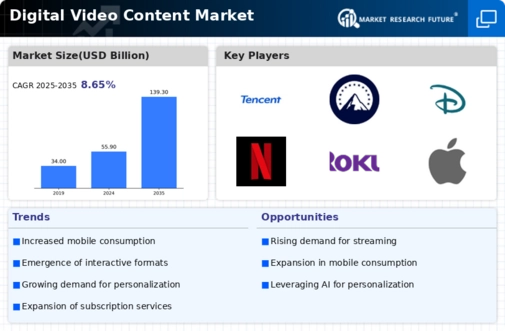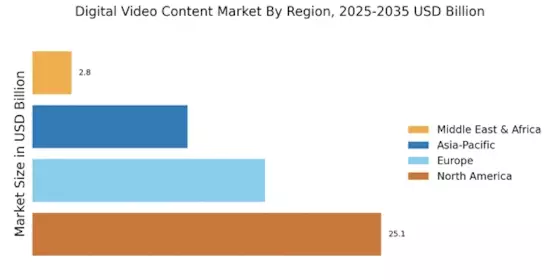Advancements in Mobile Technology
The Digital Video Content Market is significantly influenced by advancements in mobile technology. With the proliferation of smartphones and tablets, consumers are increasingly consuming video content on mobile devices. Recent statistics suggest that mobile video consumption accounts for over 70% of total online video views. This trend indicates a shift in how audiences engage with content, as mobile devices offer flexibility and convenience. Furthermore, improvements in mobile internet speeds, such as the rollout of 5G technology, are expected to enhance the viewing experience, allowing for higher quality streaming. As a result, the Digital Video Content Market is likely to see a rise in mobile-centric content strategies, catering to the growing audience of mobile viewers.
Growing Importance of Data Analytics
The Digital Video Content Market is increasingly recognizing the importance of data analytics in shaping content strategies. Streaming platforms are leveraging viewer data to understand preferences and optimize recommendations. This data-driven approach allows companies to tailor content offerings, enhancing user satisfaction and engagement. Recent findings indicate that platforms utilizing advanced analytics experience higher retention rates, as personalized content recommendations lead to improved viewer experiences. As data analytics continues to evolve, the Digital Video Content Market is expected to become more sophisticated in its approach to content delivery, ultimately driving growth and innovation.
Rising Demand for Streaming Services
The Digital Video Content Market is experiencing a notable surge in demand for streaming services. As consumers increasingly prefer on-demand content, platforms such as Netflix, Hulu, and Amazon Prime Video have expanded their offerings. Recent data indicates that the number of streaming subscribers has reached over 1 billion worldwide, reflecting a shift in viewing habits. This trend is likely to continue, as more consumers opt for subscription-based models over traditional cable services. The convenience and accessibility of streaming platforms contribute to this growth, allowing users to watch content anytime and anywhere. Consequently, the Digital Video Content Market is poised for further expansion as new players enter the market, enhancing competition and driving innovation.
Emergence of Short-Form Video Content
The Digital Video Content Market is witnessing the emergence of short-form video content as a dominant trend. Platforms like TikTok and Instagram Reels have popularized brief, engaging videos that cater to the fast-paced consumption habits of modern audiences. Data indicates that short-form videos generate higher engagement rates compared to traditional long-form content, making them appealing to marketers and content creators. This shift towards brevity is reshaping content strategies, as brands seek to capture attention quickly. The rise of short-form content is likely to influence the overall landscape of the Digital Video Content Market, prompting traditional media companies to adapt and innovate in order to remain relevant.
Increased Investment in Original Content
The Digital Video Content Market is characterized by increased investment in original content by major streaming platforms. Companies like Netflix and Disney+ are allocating substantial budgets to produce exclusive shows and movies, aiming to attract and retain subscribers. Recent reports suggest that Netflix alone plans to spend over 17 billion dollars on content in the coming year. This focus on original programming not only differentiates platforms from competitors but also enhances viewer loyalty. As the competition intensifies, the Digital Video Content Market is likely to see a proliferation of unique and diverse content offerings, catering to a wide range of audience preferences.


















Leave a Comment